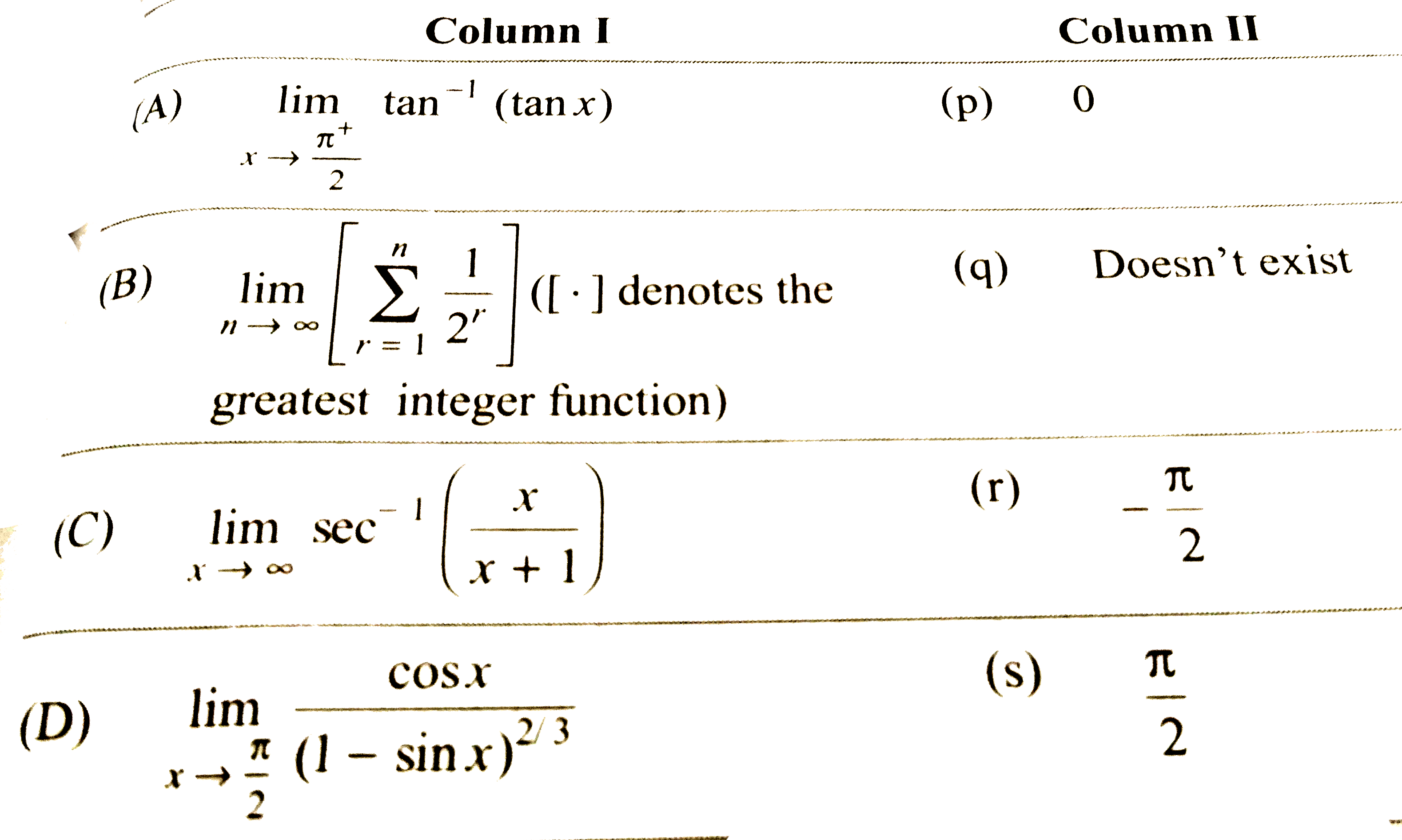If f(x)=x.2x−x1−cosx and g(x)=2x.sin(log22x) then
a. limx→0f(x)=log2
b. limx→∞g(x)=log4
c. limx→0f(x)=log4
d. limx→∞g(x)=log2Solution in Punjabi
limx→0f(x)=log2
limx→∞g(x)=log4
limx→0f(x)=log4
limx→∞g(x)=log2
The correct Answer is:C, D
Step by step video & image solution for If f(x)=(x.2^(x)-x)/(1-cosx) and g(x)=2^(x).sin((log2)/(2^(x))) then a. lim_(xto0)f(x)=log2b. lim_(xtooo)g(x)=log4c. lim_(xto0)f(x)=log4d. lim_(xtooo)g(x)=log2 by Maths experts to help you in doubts & scoring excellent marks in Class 12 exams.
Updated on:21/07/2023Topper's Solved these Questions
- LIMITSBOOK - ARIHANT MATHSCHAPTER - LIMITSEXERCISE - Exercise (Passage Based Questions)
10 Videos
- LIMITSBOOK - ARIHANT MATHSCHAPTER - LIMITSEXERCISE - Exercise (Matching Type Questions)
3 Videos
- LIMITSBOOK - ARIHANT MATHSCHAPTER - LIMITSEXERCISE - Exercise (Single Option Correct Type Questions)
38 Videos
- INVERSE TRIGONOMETRIC FUNCTIONSBOOK - ARIHANT MATHSCHAPTER - INVERSE TRIGONOMETRIC FUNCTIONSEXERCISE - Exercise (Questions Asked In Previous 13 Years Exam)
8 Videos
- LOGARITHM AND THEIR PROPERTIESBOOK - ARIHANT MATHSCHAPTER - LOGARITHM AND THEIR PROPERTIESEXERCISE - Exercise (Questions Asked In Previous 13 Years Exam)
4 Videos
Similar Questions
If limx→af(x)=1 and limx→ag(x)=∞ then limx→a{f(x)}g(x)=elimx→a(f(x)−1)g(x)
limx→0(sinxx)sinxx−sinx is equal to
View SolutionMatch the statements of Column I with values of Column II.

View Solutionlimx→0sin(πcos2(tan(sinx)))x2 is equal to
View SolutionIf α=3sin−1(611andβ=3cos−1(49), where the inverse trigonometric functions take only the principal values, then the correct options (s) is (are)
View SolutionIn Which quadrant Point (−2,−3) will be lie.
View SolutionIf f(x)=sgn(x) and g(x)=x3,then prove that limx→0f(x).g(x) exists though limx→0f(x) does not exist.
View SolutionIf f(x)=x.2x−x1−cosx and g(x)=2x.sin(log22x) then
View SolutionIf limx→af(x)=1 and limx→ag(x)=∞ then limx→a{f(x)}g(x)=elimx→a(f(x)−1)g(x) limx→0(x−1+cosxx)1x is equal to
View SolutionIf limx→af(x)=1 and limx→ag(x)=∞ then limx→a{f(x)}g(x)=elimx→a(f(x)−1)g(x) limx→0(ax+bx+cx3)2x is equal to
View Solutionयदि f(x)=ax2+bx2+1,limx→0f(x)=1 तथा limx→∞f(x)=1 तब सिद्ध कीजिए कि f(−2)=f(2)=1
View Solutionयदि f एक फलां इस प्रकार है कि f(−x)=−f(x) तथा limx→0f(x) का अस्तित्व है तब सिद्ध कीजिए कि limx→0f(x)=0
View Solutionयदि f(x)=ax+bx+1,limx→0f(x)=2 व limx→∞f(x)=1 तो सिद्ध कीजिए कि f(−2)=0
View Solutionसिद्ध कीजिए कि
limx→010x−2x−5x+1xtanx=(log5)(log2)
View SolutionIf f(x+y)=f(x)f(y) and f(x)=1+xg(x) G(x), where limx→0g(x)=a and limx→0G(x)=b. Then f'(x) is equal to :
View SolutionIf f(x)=sgn(x) and g(x)=x3,then prove that limx→0f(x).g(x) exists though limx→0f(x) does not exist.
View SolutionIf limx→∞f(x) exists and is finite and nonzero and if limx→∞{f(x)+3f(x)−1f2(x)}=3, then the value of limx→∞f(x) is _______.
View Solution
